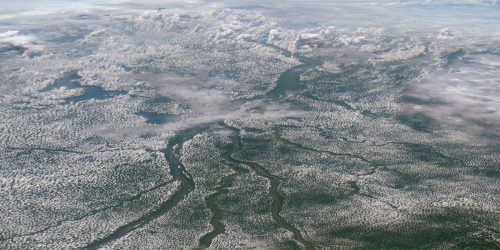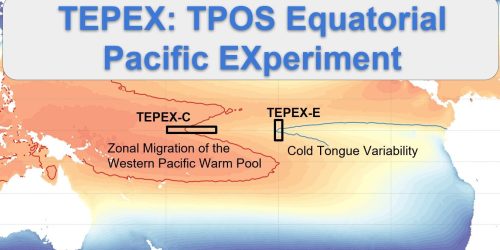Today, the Department of Commerce and NOAA announced $7.2 million in funding to external partners and NOAA collaborators to improve climate projections that will help communities, businesses and industries better plan for the future. The projects aim to produce climate projections multiple years and decades in advance to help communities take actions to reduce damage and losses from future weather and climate extremes.
“NOAA has a long history of expert weather and climate forecasting,” said U.S Secretary of Commerce Gina Raimondo. “This new set of projects, which were made possible by funding from President Biden’s Investing in America agenda and the Inflation Reduction Act, are designed to significantly advance the quality and breadth of products NOAA provides to better prepare the nation, our communities and industries for the impacts of climate change in future years and decades.”
The funding will support 13 projects to advance projections of tropical cyclones, heat extremes, precipitation and global weather and climate drivers such El Nino-Southern Oscillation (ENSO) and the Atlantic Meridional Overturning Circulation (AMOC).
Researchers will use climate model to project future extremes
The initiative, Climate Futures: Projections for Societally-Relevant Problems, will be managed by the NOAA Climate Program Office’s Modeling, Analysis, Predictions and Projections Program. A key aspect of the initiative will be to test the quality of the information produced by NOAA’s Geophysical Fluid Dynamics Laboratory’s climate model, called the Seamless System for Prediction and EArth System Research (SPEAR), to simulate near-term and future high-impact extreme climate events.
“The NOAA Geophysical Fluid Dynamics Lab has pioneered Earth System models from its founding in 1955,” said Sarah Kapnick, Ph.D., NOAA chief scientist. “The lab’s SPEAR climate model — the first high resolution model used for seamless prediction across seasonal to decadal timescales — will be used to create new products and services to help build the nation’s climate resilience.”
The 13 projects range in scope and focus and work together to improve climate projections that will help communities take proactive measures to reduce the impact of climate hazards. One project, a collaboration between Utah State University, University of Colorado Boulder, University of Nebraska-Lincoln, the Desert Research Institute and NOAA, will advance climate prediction of extreme flooding to help inform industry building codes recommended by the American Society of Civil Engineers. The research will also develop multi-decadal projections of the frequency of rain-on-snow events and annual peak snow loads for buildings. The goal is to assist engineers in cold climates with information to design buildings that prevent structural failures due to snow loads and rain-on-snow events.
Another research collaboration is between the National Center for Atmospheric Research, Pennsylvania State University and NOAA, and aims to develop multi-decadal projections for extratropical cyclones, which include blizzards and Nor’easters. Extratropical cyclones are the most common drivers of weather extremes in the mid- and high-latitude regions of the United States. These storms draw energy from the interaction of cold and warm air masses. There remain significant uncertainties in how climate change is affecting these cyclones and how their impacts, such as heavy rain, snow and strong winds, are changing and will change in the future.
The 13 new Funded projects are:
- Constraining near-term U.S. hydroclimate and extreme-event projections with SST pattern storylines: The project will enhance our understanding of how Pacific sea surface temperature patterns influence U.S. hydroclimate. The focus will be on the Colorado River Basin, where water resource management is vital to the economy. The project aims to reduce uncertainty in hydroclimate projections, engage with local stakeholders for informed decision-making, and collaborate with Indigenous tribes.
- Project PI: Maria Rugenstein, Colorado State University (Fort Collins, CO 80523-1371)
- Co-PI: Russ Schumacher, Colorado State University (Fort Collins, CO 80523-1371)
- Co-PI: Ming Zhao, NOAA Geophysical Fluid Dynamics Laboratory (Princeton, NJ 08540)
- Project PI: Maria Rugenstein, Colorado State University (Fort Collins, CO 80523-1371)
- Near-term climate and extreme weather projections derived from stratosphere-troposphere coupling in Earth System Models: This project aims to improve the accuracy of future climate projections, especially regarding temperature and precipitation extremes by focusing on the connections between Earth’s stratosphere and troposphere and the impact of that connection on climate projection uncertainty. The project plans to use various simulations and historical data to evaluate and quantify uncertainties in climate models, potentially leading to more reliable climate projections, in alignment with NOAA’s climate program goals.
- Project PI: Amy Butler, NOAA Chemical Sciences Laboratory (Boulder, CO 80305)
- Confronting climate model trends with observations: Extratropical storm tracks and their associated extreme events: The project will analyze trends in storm tracks and associated extreme events across seasons and regions using various datasets. It aims to assess the impact of factors like sea surface temperature and model resolution. The goal is to improve the reliability of Earth system information and climate predictions.
- Project PI: Tiffany Shaw, The University of Chicago (Chicago, IL 60610)
- Co-PI: Isla Simpson, National Center for Atmospheric Research (Boulder, CO 80307)
- Project PI: Tiffany Shaw, The University of Chicago (Chicago, IL 60610)
- Understanding future projections of tropical cyclone landfall and precipitation: The project will evaluate SPEAR’s tropical cyclone landfall statistics, identify model biases and assess uncertainties in future projections.
- Project PI: Jorge Garcia Franco, Lamont-Doherty Earth Observatory, Columbia University (New York, NY 10027-7922)
- Co-PI: Chia-Young Lee, Lamont-Doherty Earth Observatory, Columbia University (New York, NY 10027-7922)
- Co-PI: Suzana Camargo, Lamont-Doherty Earth Observatory, Columbia University (New York, NY 10027-7922)
- Co-PI: Michael Tippett, Lamont-Doherty Earth Observatory, Columbia University (New York, NY 10027-7922)
- Project PI: Jorge Garcia Franco, Lamont-Doherty Earth Observatory, Columbia University (New York, NY 10027-7922)
- Projecting Compound Tropical Cyclone-Heat Extremes in a Changing Climate: The project will estimate the emerging risk of compound extreme events involving tropical cyclones and climate change induced extreme heat using the GFDL SPEAR modeling system, which simulates tropical cyclones and their interactions with heat extremes. The research will provide important insights for public health and power system resilience.
- Project PI: Jane Baldwin, University of California, Irvine (Irvine, CA 92697-3100)
- Co-PI: Suzana Camargo, Lamont-Doherty Earth Observatory, Columbia University (New York, NY 10027-7922)
- Co-PI: Chia-Young Lee, Lamont-Doherty Earth Observatory, Columbia University (New York, NY 10027-7922)
- Co-PI: Mona Hemmati, Lamont-Doherty Earth Observatory, Columbia University (New York, NY 10027-7922)
- Project PI: Jane Baldwin, University of California, Irvine (Irvine, CA 92697-3100)
- Impacts of Regional Aerosol Emissions Uncertainty on Societally-Relevant Climate Hazard Projections over the Continental U.S. in GFDL-SPEAR: The project will improve decadal climate projections in the U.S. by considering the significant influence of rapidly changing human-caused particulate pollution on climate hazards. It will also compare SPEAR’s performance with other models to identify improvements. The findings will enhance the accuracy of climate projections and contribute to climate readiness efforts.
- Project PI: Geeta Persad, University of Texas at Austin (Austin, TX 78712)
- Developing projections of El Nino Southern Oscillation activity and associated coastal hazards: An application to the Hawaiian and US-affiliated Pacific Islands: The project aims to improve multi-decadal projections of ENSO and its associated coastal hazards along the Pacific rim. The project has three main goals: (1) Develop dynamic methods for ENSO projections. (2) Combine refined ENSO projections with observed relationships to predict coastal risks. (3) Extend the approach to vulnerable Pacific Islands.
- Project PI: Fei-Fei Jin, University of Hawaii (Honolulu, HI 96822)
- Co-PI: Zhaoqing Yang, Pacific Northwest National Laboratory (Richland, WA, 99354)
- Co-PI: Malte Stuecker, University of Hawaii (Honolulu, HI 96822)
- Co-PI: Ning Li, University of Hawaii (Honolulu, HI 96822)
- Co-PI: Andrew Wittenberg, NOAA Geophysical Fluid Dynamics Laboratory (Princeton, NJ 08540)
- Project PI: Fei-Fei Jin, University of Hawaii (Honolulu, HI 96822)
- Future projections of extreme heat events in SPEAR ensemble simulations: The project will evaluate the capability of NOAA’s SPEAR system model to simulate historical extreme heat events in the contiguous U.S. and Europe. The research will examine how to attribute these events to factors such as atmospheric warming, high-pressure systems and jet streams. This study will provide valuable insights into the causes of extreme heat events and model biases in SPEAR and recent GFDL models.
- Project PI: Ping Liu, State University of New York at Stony Brook (Stony Brook, NY 11794)
- Co-PI: Kevin Reed, State University of New York at Stony Brook (Stony Brook, NY 11794)
- Co-PI: Levi Silvers, State University of New York at Stony Brook (Stony Brook, NY 11794)
- Project PI: Ping Liu, State University of New York at Stony Brook (Stony Brook, NY 11794)
- Multi-decadal projections of extratropical cyclones and their associated extreme precipitation, snowfall, and surface winds: The project will use three large climate model ensembles to project extratropical cyclones, which typically occur in the mid-latitudes. Extratropical cyclone behavior and their storm-scale characteristics in a warming climate are currently uncertain, and large ensembles are needed to separate those that are part of a climate change trends from those caused by natural variability. The research will assess model performance, investigate the influence of large-scale climate patterns, and determine when climate change signals emerge from natural variability. Collaboration with civil engineers on this project will aid in incorporating climate change into engineering decisions.
- Project PI: Rachel McCrary, National Center for Atmospheric Research (Boulder, CO 80305)
- Co-PI: Melissa Bukovsky, National Center for Atmospheric Research (Boulder, CO 80305)
- Co-PI: Mari Tye, National Center for Atmospheric Research (Boulder, CO 80305)
- Co-PI: Colin Zarzycki, The Pennsylvania State University (University Park, PA 16802)
- Project PI: Rachel McCrary, National Center for Atmospheric Research (Boulder, CO 80305)
- Improving Climate Predictions by Rigorously Assessing Model Fidelity and Biases: The project will assess how well various climate models drivers (greenhouse gases, solar radiation, aerosols, etc.) are represented in SPEAR, Coupled Model Intercomparison Project Phase 6 (CMIP6) climate model, and large ensembles, with a focus on El Nino, North Atlantic, and Pacific sea surface temperatures. The project also examines connections between ocean and land temperature and precipitation. The findings will inform model development for improved climate prediction systems.
- Project PI: Timothy DelSole, George Mason University (Fairfax, VA 22030)
- Co-PI: Michael Tippett, Columbia University (New York, NY 10027)
- Project PI: Timothy DelSole, George Mason University (Fairfax, VA 22030)
- Detection of Atlantic Meridional Overturning Circulation changes and their potential impact on sea level and storm surges along the U.S. east coast: The project will explore the connection between Atlantic Meridional Overturning Circulation, mean sea level, and extreme sea level events on decadal timescales, using observational data and GFDL SPEAR model simulations. It will assess AMOC’s role in driving extreme sea level events, investigate multiyear to decadal sea level predictability, analyze model resolutions, and study extreme sea level case studies to improve understanding and prediction of sea level changes.
- Project PI: Liping Zhang, NOAA Geophysical Fluid Dynamics Laboratory (Princeton, NJ 08540)
- Co-PI: Thomas Delworth, NOAA Geophysical Fluid Dynamics Laboratory (Princeton, NJ 08540)
- Project PI: Liping Zhang, NOAA Geophysical Fluid Dynamics Laboratory (Princeton, NJ 08540)
- Understanding the Evolving Threat of Snow Loads and Rain on Snow Events to Structural Safety: The project will enhance our understanding of how extreme snow loads and rain-on-snow events evolve in a changing climate in the contiguous United States. The researchers will use SPEAR and other climate model data to simulate factors affecting snow accumulation and rain on snow incidents, like temperature and precipitation.
- Project PI: Brennan Bean, Utah State University (Logan, UT 84322)
- Co-PI: Wei Zhang, Utah State University (Logan, UT 84322)
- Co-PI: Dan McEvoy, Desert Research Institute (Reno, NV 89512)
- Co-PI: Abbie Liel, University of Colorado –Boulder (Boulder, CO 80309)
- Co-PI: Marc Maguire, University of Nebraska – Lincoln (Omaha, NE 68182)
- Project PI: Brennan Bean, Utah State University (Logan, UT 84322)
- Bridging Predictions and Projections: Understanding Predictability from Initialized Multi-Year to Decadal Predictions for High-Impact Climate Futures: The funded project will determine whether the North Atlantic Subtropical High can serve as a source of predictability for multi-year to decadal climate futures in areas such as hydrology, extreme temperatures, and coastal inundation. It will investigate whether initialized multi-year to decadal predictions offer better accuracy for predicting these high-impact climate events compared to uninitialized projections, which has not been thoroughly explored in previous research.
- Project PI: Kathleen Pegion, University of Oklahoma (Norman, OK 73072-7307)
- Co-PI: Emily Becker, University of Miami (Miami, FL 33149)
- Project PI: Kathleen Pegion, University of Oklahoma (Norman, OK 73072-7307)
Please visit NOAA’s Inflation Reduction Act website to learn about current and future funding opportunities.










